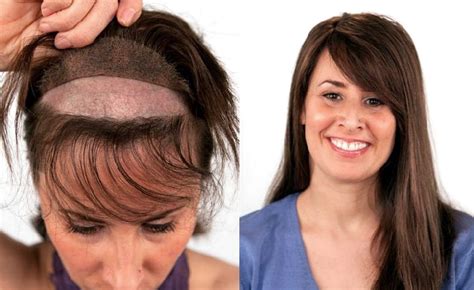Losing your hair can be a devastating experience for women. It can lead to feelings of self-consciousness, shame, and even depression. But there is hope. Hair replacement can help women regain their confidence and feel like themselves again.

There are a variety of hair replacement options available for women, each with its own benefits and drawbacks. In this article, we will discuss the 5 most popular hair replacement options for women:
- Wigs
- Hair extensions
- Hair toppers
- Scalp micropigmentation
- Hair transplantation
1. Wigs
Wigs are the most common type of hair replacement for women. They are made from a variety of materials, including human hair, synthetic hair, and a blend of the two. Wigs come in a wide range of styles, lengths, and colors, so you can find one that matches your natural hair perfectly.
Pros of wigs:
- Affordable and easy to find.
- Can be styled in a variety of ways.
- Can be removed at night.
Cons of wigs:
- Can be uncomfortable to wear for long periods of time.
- Can be difficult to keep in place, especially in windy conditions.
- Can be expensive, especially if you buy a high-quality wig.
2. Hair extensions
Hair extensions are another popular hair replacement option for women. They are made from human hair or synthetic hair and are attached to your natural hair using a variety of methods, such as glue, tape, or microbeads. Hair extensions can be used to add length, volume, or color to your hair.
Pros of hair extensions:
- Can be customized to match your natural hair.
- Can be worn for a long period of time without damaging your hair.
- Relatively affordable.
Cons of hair extensions:
- Can be time-consuming to apply and remove.
- Can be uncomfortable to sleep in.
- Can damage your hair if they are not applied or removed properly.
3. Hair toppers
Hair toppers are similar to hair extensions, but they are smaller and are designed to cover only the top of your head. Hair toppers are a good option for women who are experiencing hair loss in the crown of their head.
Pros of hair toppers:
- Easy to apply and remove.
- Can be worn for a long period of time without damaging your hair.
- More affordable than wigs.
Cons of hair toppers:
- Can be difficult to blend with your natural hair.
- Can be uncomfortable to wear in hot weather.
4. Scalp micropigmentation
Scalp micropigmentation is a non-surgical hair replacement procedure that involves implanting pigment into the scalp to create the illusion of hair follicles. Scalp micropigmentation is a good option for women who are experiencing hair loss all over their head.
Pros of scalp micropigmentation:
- Permanent solution to hair loss.
- Low-maintenance.
- Can be customized to match your natural hair color.
Cons of scalp micropigmentation:
- Can be expensive.
- Can be painful.
- Can fade over time.
5. Hair transplantation
Hair transplantation is a surgical hair replacement procedure that involves transplanting hair follicles from one part of your body to your scalp. Hair transplantation is a good option for women who are experiencing hair loss in a specific area of their head.
Pros of hair transplantation:
- Permanent solution to hair loss.
- Natural-looking results.
- Can be used to restore hair to any area of the scalp.
Cons of hair transplantation:
- Can be expensive and time-consuming.
- Can be painful.
- Can leave scars.
Which hair replacement option is right for you?
The best hair replacement option for you will depend on your individual needs and preferences. If you are not sure which option is right for you, consult with a hair loss specialist.
Losing your hair can be a difficult experience, but it is important to remember that there are many hair replacement options available to help you regain your confidence and feel like yourself again. Talk to your doctor or a hair loss specialist to learn more about the different options and find the one that is right for you.
